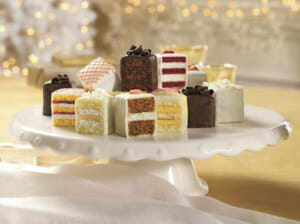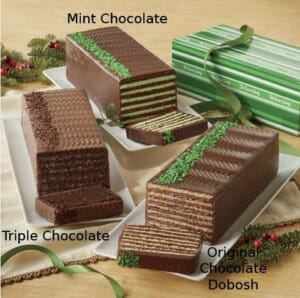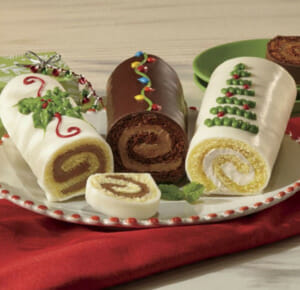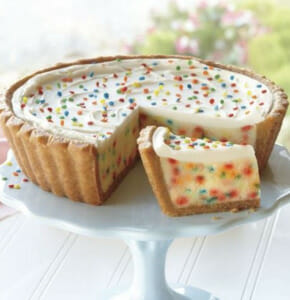What Is Fruitcake? An Enduring Holiday Tradition
People love to make fun of this seemingly indestructible Christmas classic, but what is fruitcake? Where did fruitcake come from? All we know is that it’s good!
“There is only one fruitcake in the entire world, and people keep passing it around.” – Johnny Carson

What Is Fruitcake?
We’ve all heard the jokes referring to fruitcake’s immense density, or its extreme shelf life. Its detractors would have you believe that it’s as heavy as a doorstop and made to be passed down through the generations, getting an annual christening of liquor every Christmas before being put away for the following year. And to be honest, there’s more than a little truth to it.
Fruitcake—that dense amalgam of fruits, nuts, and just enough rich cake to hold them together—is one of the heaviest baked goods out there. It’s also one of the few baked goods that can benefit from aging…provided it’s done right. But at the end of the day (or, more accurately, the end of the year), enough people love—and eat—fruitcake to make it a $100 million per year business. And, its legendary lasting power is not limited to the cake itself: the history of fruitcake is long, and fruitcake has existed in one form or another since Roman times.

What is in a Fruitcake?
The Swiss Colony has been baking fruitcakes since the early 1960s, and has continually perfected the recipe over the years to deliver the right blend of density, moistness, and flavor. The current formulation contains a whopping 70% dried fruit and nuts: papayas, raisins, pineapple, cherries, pecans, and English walnuts. These ingredients are bound together by a buttery-rich batter, brown sugar, and baked in loaf pans to form a rich, dark cake.

A pattern of more dried fruits and fancy-grade pecan halves are beautifully hand-arranged on top. The top is then hand-brushed with a sugar glaze, and cooked in small batches in copper kettles, to set the design and add the final glistening touch. While mass-produced, the fruitcakes are made with premium ingredients and an uncommonly personal touch.


The Origin of Fruitcake: The Original Energy Bar
To sustain their troops in battle, the ancient Romans concocted a sort of energy bar called satura, which consisted of pomegranate seeds, pine nuts, raisins, barley mash, and honeyed wine. Eventually becoming popular as a dessert for special occasions, it was packed with calories in the form of healthful carbs and beneficial fats, and lasted long enough to fortify a soldier through a long, exhausting campaign. A similar form of fruitcake was used by Christian armies during the Crusades.
Dried fruits became more readily available to western Europeans during the Middle Ages, and variations on the fruitcake emerged: Italy’s panforte and panettone, Germany’s powdered sugar-coated stollen, and Britain’s plum pudding.
The British form started as “plum porridge”; more liquid than solid, it was not sweet at all. During Shakespearean times it contained meat, wine, sherry, fruit juices, sugar and various preserved fruits. Over the years, the recipe changed to eliminate the meat, add more fruit, and bake it into what became known as “plum pudding” (more a plum cake than what Americans would know as a pudding). It was this form that became famous in the Christmas carol, “We Wish You a Merry Christmas,” in which the carolers implore, “Now bring us some figgy pudding.” The carol has its roots in the 19th century; it was the practice of English nobles in Victorian England to feed the poor carolers with a slice of this pudding, which is probably how the Christmas fruitcake came to be so intertwined with Christmas.

The tradition was brought to America by the colonists in the years before the Revolution, and by the late 1800s the fruitcake was gifted in decorated tins. Today, The Swiss Colony (America’s largest hand-decorating baker) produces more than 66,000 fruitcakes—nearly 110,000 pounds—per year in its Monroe, Wisconsin, bakery, and ships them nationwide in its own festive tins.


The Care and Feeding of Fruitcake
Wait…what? Is this a cake or a pet? Well, to many people, the holiday fruitcake is a living tradition that requires tending, and they order it appropriately in advance to account for the aging process.
It may seem strange to age a food product, except for wine and cheese…and, under carefully controlled conditions, beef. OK, so maybe aging food isn’t all that bizarre. But baked goods? In this case, yes. All that fruit contains compounds called tannins which, in addition to being good for you, have a slight natural bitterness that softens with age. In fact, this is why red wines are aged: the tannins found in the grape skins mellow over time. At any rate, most fruitcake fanatics wouldn’t dream of serving a fruitcake until it’s aged at least a month.

Now, don’t feel as though you need to age your fruitcake. Any fruitcake you buy is perfectly delicious to eat right out of the package, and has been quietly ripening in refrigeration for a while before shipping (sealed, of course, to stay moist). But many folks like to moisten it further with one element most manufacturers leave out: alcohol.
Brandy, whiskey, or rum has been a time-honored ingredient of traditional fruitcakes for centuries. Out of respect for personal preferences and sensitivities, The Swiss Colony leaves out this step, adding only a bit of rum flavoring for authenticity. But anyone buying a fruitcake can “feed” it easily, and add their own by following this simple process:
- Using a clean wooden skewer, poke holes all over your fruitcake. Be sure to pierce the fruitcake deeply to encourage the liquid to penetrate to the bottom.
- Slowly drizzle 1–2 tablespoons of rum, brandy, or whiskey over the fruitcake. (Feel free to use spiced rum or Grand Marnier for extra spice or orange flavor if you wish.)
- Wrap your fruitcake tightly in baking paper or aluminum foil, place it in a sealed container, and store in a cool, dry place.
- Repeat this process every two weeks for two or three months. Remember to always use a clean skewer so as not to introduce bacteria.
People who follow this practice say a properly done fruitcake will last months or even years in a cool, dry place, but we recommend enjoying the fruits of your labors during the holidays and buying a new one next year!

To serve fruitcake, cut it with a long, sharp, serrated knife into approximately 1-inch slices. Fruit cake — especially if it has been moistened — can be served alone; however, there are several ways to make it even more delicious. You can warm it up by lightly toasting it, and then add a scoop of vanilla bean ice cream and sip a cup of strong, dark, gourmet coffee.
Or, instead of a decadent dessert, serve it with a sharp cheddar or warmed brie cheese and pour a glass of red wine. Enjoy!
23 comments
Leave a Reply
Categories: Bakery




Hi,
Our family has enjoyed Swiss Colony fruit cake for many years! Are there any fruit cake historians out there who could answer my child’s questions about fruit cake. 1) When or why did fruit cake begin taking the round/cylindrical form? 2) Was it produced in a square or rectangular shape in the early years? Thank you in advance for your help.
Kind regards-
Very disappointed on the taste of the sugar free fruitcake, would not recommend it
We’re sorry to hear about your disappointment with the sugar-free fruitcake, Kathy! We appreciate your honest feedback. If you would like further assistance, please contact us at socialcs@sccompanies.com.
I love your products and your fruit cake is absolutely devne. Have you considered making fruit cake cookies also? I served them on year and the were an absolute smash. Thank you
Thank you, Ronald! We’re thrilled to hear that you love our products, especially the fruit cake. Your suggestion for fruit cake cookies is fantastic! We’ll definitely consider it, and we appreciate your input. If you have any more ideas or feedback, feel free to share!
The Christmas holidays brings back so many fond memories of my mom and dad. Every year they would order ft nuts and oh yes, fruitcake from Swiss Colony. My dad was the only one to eat the fruit cake.😊 Good memories though. Thanks Swiss Colony
We’re touched to be a part of your holiday memories, especially with the tradition of nuts and fruitcake. It’s heartwarming to hear about the good memories with your mom and dad. Thank you for sharing, and we’re here to continue making special moments with you. 😊 If you have any more memories to share, feel free to send us a submission over at https://www.swisscolony.com/blog/holiday/share-your-spring-holiday-traditions-and-stories
I cannot eat nuts anymore. A lot of people cannot eat nuts but love fruit cake. It would be nice to have a fruit cake without nuts that I do not have to make myself. Wonderful Chefs like yours should be able to come up with something for us that are allergic or cannot eat nuts anymore. Thanks for your consideration🌺🙏
THIS IS BY FAR THE BEST FRUIT CAKE THAT I HAVE EVER EATEN!
I make my cake in September. Our cake does not contain large pieces of fruit but cut up small pieces and no nuts. The recipe has been in the family for over 200 years. We turn the oven down to 200F and let it cook over night. This way it comes out really dark and adding the rum or brandy over the three months makes it really moist. My American friends just love my cake and look foreword to it every year.
Can I freeze fruit cake batter and bake the cake later?
My father and I love fruitcake but are having a horrible time finding one that does not contain citrus rinds. Could I see an ingredient list for your Christmas Fruitcake? I would love to surprise my father.
For the last 2 years Swiss Colony has offered a new fruit cake that has more fruit, nuts, etc. This year I have not been able to find it in the catalog nor on the website. My mother started a tradition of getting a fruit cake (along with several other tasty items) from Swiss Colony when I was a child and I have been carrying on the tradition since she passed away In the 1980’s. My sister -in-law loved the new super fruit cake I had purchased for her and my brother for the last 2 years. Would you please let me know if it Will be available for Christmas this year?
I learned to make fruitcake and peanut brittle from my Mother who died in 2003. I believe I have even improved upon her recipes for both. I have yet to try another that are better, some pretty close.
For many years I have made both for family and friends to their delite of course. My wife receives many compliments from those who do not know who is the cook. She has tried and failed at both. I know Mom likes my changes in the peanut brittle, don’t think she ever tried my fruit cake.
I would love to send a sample of each for your opinnions for improvements.
My fruit cake was under the tree it was nor refrigerated is it safe to eat ?
Yes, it will be fine!
yes, Fruitcakes are slow-cooked which prevents them from growing bacteria. If kept in a cool dry place, a fruitcake can survive up to a month and refrigerated up to a year or longer.
I LOVE Fruitcake, my Mum, made it every year, she also made Plum pudding and an amazing hot butterscotch sauce to pour on top
i ate fruitcakes for years that my mom made until she got too sick to make them.she made alot of foods,desserts by scratch all of the time.
can i get a fruit cake with no nuts please can not eat nuts
Very sorry, but we don’t make fruitcake without nuts.
Yes you can bake a fruit cake without nuts just add more fruits to your dough …subritute fir your nuts. Add for the bit more moisture while baking maybe you can on using some freshly peel fresh orange juice with the pitchs.
Do you folks still make the variety of fruitcake that your company made with macadamia nuts and pineapple? I recall having some of it back in the 80s. It was delicious!! I’d love to have some of it again!